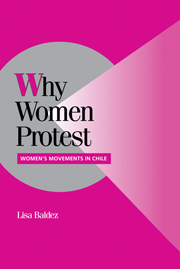Book contents
1 - WHY WOMEN PROTEST: TIPPING, TIMING, AND FRAMING
Published online by Cambridge University Press: 06 July 2010
Summary
The socialist government of President Salvador Allende (1970–3) and the military government of General Augusto Pinochet (1973–90) represented two of the most divisive periods in the recent history of Chile. These two regimes differed in almost every respect. The Allende government attempted to pave a “peaceful road to socialism,” implementing Marxist reforms within a democratic framework. Allende nationalized industries, accelerated the process of agrarian reform, and incorporated peasants and workers into the political system on a massive scale. When the military took power in a coup in 1973, the Pinochet regime put a decisive end to Chile's experiment with socialism, not only undoing Allende's reforms but implementing a new order altogether. Pinochet's efforts to reconstruct the country extended far beyond replacing civilian leaders with military officials. He opened the economy to the free market and built Chile's political institutions to establish order and stability. A fierce campaign of repression limited the expression of public opposition to these policies.
Despite the stark differences between these two regimes, they shared an important, even remarkable feature in a patriarchal culture such as Chile's: the mobilization of women. In both of these tumultuous periods, women mobilized to bring down the government in power and demanded a role in the new political order. The anti-Allende women organized the famous “March of the Empty Pots” and pressured the military to heed women's call for intervention. During the Pinochet regime, women organized around the slogan “Democracy in the Country and in the Home,” punctuating the pro-democracy movement with demands for human rights, economic justice, and women's equality.
- Type
- Chapter
- Information
- Why Women ProtestWomen's Movements in Chile, pp. 1 - 20Publisher: Cambridge University PressPrint publication year: 2002

